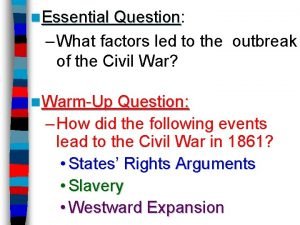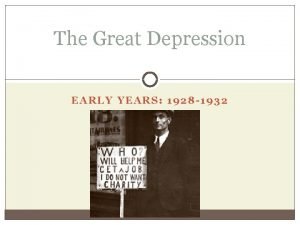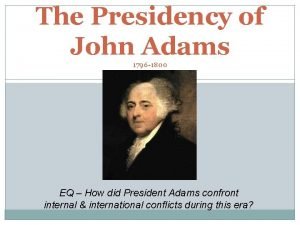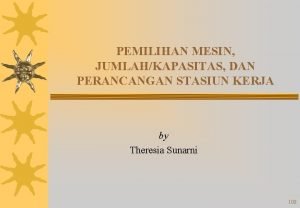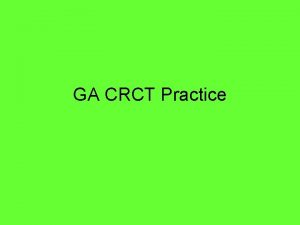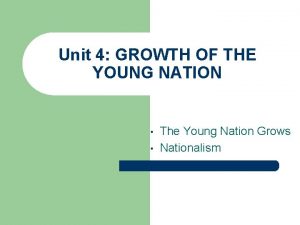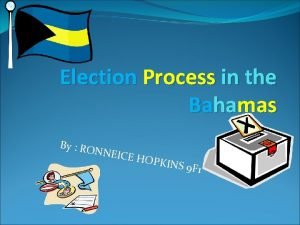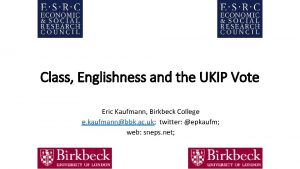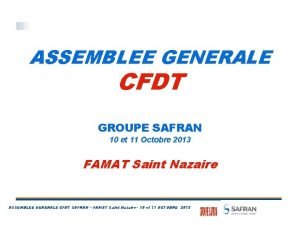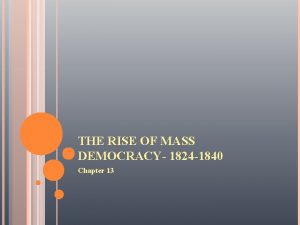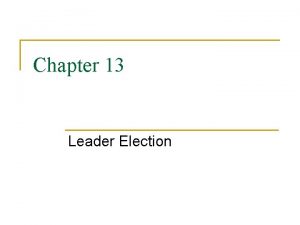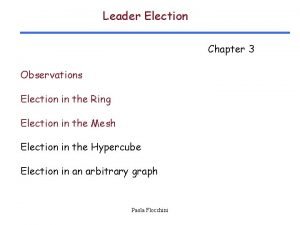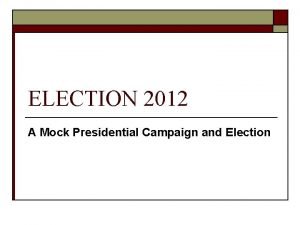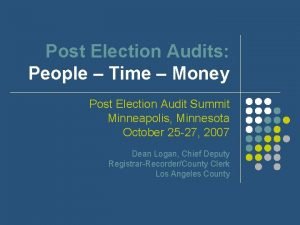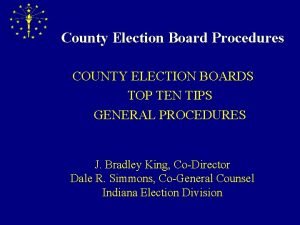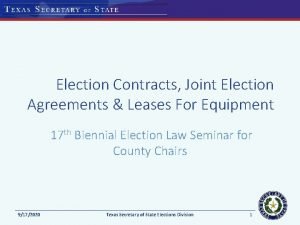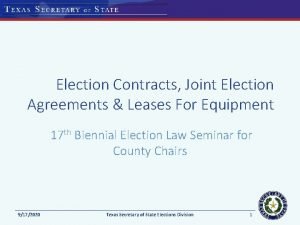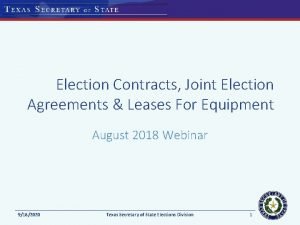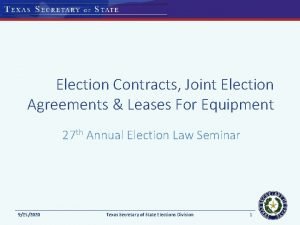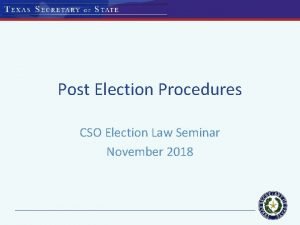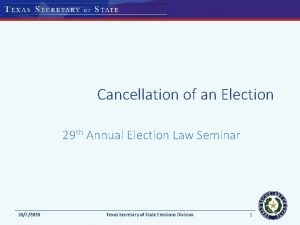Leader Election Ch 3 4 1 15 2










































- Slides: 42

Leader Election Ch. 3, 4. 1, 15. 2 Chien-Liang Fok 11/25/2020 CS 673 Fall 2003 1

Leader Election process connection n Numerous processes are connected in a digraph One process eventually declares itself leader Motivation: ¨ token ring networks ¨ efficient communication (e. g. , lighthouse routing) 11/25/2020 CS 673 Fall 2003 2

Impossibility Result for Identical processes n Cannot solve leader election problem with identical processes ¨ Proof by induction on the sequence of states ¨ Every process will declare self as leader simultaneously n Solution: Assume identical processes distinguished by a unique identifier (UID) ¨ UID 11/25/2020 is a positive integer CS 673 Fall 2003 3

Synchronous Network All processing done in lock-step formation n There are rounds of computation n Message-passing is done between rounds n 11/25/2020 CS 673 Fall 2003 4

Model 1: Synchronous Ring 1 5 2 4 3 n processes connected in a ring n Processes can distinguish clockwise from counterclockwise neighbor n 11/25/2020 CS 673 Fall 2003 5

Variations on the Theme Non-leaders may have to declare themselves as such n Ring may be unidirectional or bidirectional n Each node may or may not know n, the size of the ring n 11/25/2020 CS 673 Fall 2003 6

LCR Algorithm 1 5 n n n Developed by Le Lann, Chang, and Roberts (1978) Unknown n, unidirectional ring, only leader outputs General idea: 2 4 3 ¨ Every process passes its UID around the ring ¨ Upon reception, compare to own UID n n n 11/25/2020 If larger: Pass to next process If smaller: Discard If equal: Declare self as leader CS 673 Fall 2003 7

LCR Algorithm Proof 1 5 2 4 n n 3 r UIDmax r is the number of rounds Proof by induction on r ¨ After r rounds, the node r away from the Pmax will be sending UIDmax ¨ When r = n, UIDmax will have traveled around the ring 11/25/2020 CS 673 Fall 2003 8

Halting LCR n LCR algorithm never halts ¨ Non-leaders messages n continuously listen for incoming Have leader pass a report message around the ring ¨ This is the general way to transform a non-halting algorithm into a halting one ¨ Transformation Cost: n n 11/25/2020 n additional rounds n additional messages CS 673 Fall 2003 9

LCR Complexity Analysis n Time Complexity: Non-Halting 11/25/2020 Time Communication n 2 n O(n 2) CS 673 Fall 2003 10

HS Algorithm Developed by Hirshberg and Sinclair n Achieves O(n log n) communication complexity, O(n) time complexity n Assumptions: 1 n ¨ Unknown n ¨ Bidirectional ring 5 2 4 11/25/2020 CS 673 Fall 2003 3 11

HS Algorithm (Cont. ) n General idea: 1 5 2 4 ¨ Operate 3 in phases 0, 1, 2, . . . ¨ During phase p, send UID in both directions for a distance of 2 p Processing of received UID same as LCR n If its UID comes back, continue to next round n If it receives its outbound UID, declare self as leader n 11/25/2020 CS 673 Fall 2003 12

Comparison-based Algorithms n LCS and HS are comparison-based algorithms ¨ Only n The communication lower-bound is: Ω(n log n) ¨ See n compare UIDs Lynch section 3. 6 for proof Is this the lower bound in general? 11/25/2020 CS 673 Fall 2003 13

Time. Slice Algorithm Non-comparison-based algorithm n Achieves O(n) communication complexity n Assumptions: n ¨n is known to all processes ¨ Unidirectional communication 11/25/2020 CS 673 Fall 2003 14

Time. Slice Algorithm (Cont. ) n 1 5 General idea: phases 1, 2, 3, . . . ¨ Phase p 2 ¨ Have n n 4 3 Contains n rounds, rounds (p-1)n + 1, …, pn If a node with UID p exists, it is circulated around the ring ¨ If we reach round (p-1)n + 1 and the node with UID = p has not received any UID before, declare self as leader n Process with minimum UID becomes the leader 11/25/2020 CS 673 Fall 2003 15

Time. Slice Algorithm (Cont. ) n Proof foundation: ¨ No messages are sent except between rounds (UIDmin-1) ·n + 1 and UIDmin·n Only n messages are sent n Problem: n ¨ Time complexity is n · UIDmin ¨ Unbounded! 11/25/2020 CS 673 Fall 2003 16

Variable. Speeds Algorithm n n Another non-comparison-based algorithm Does not require knowledge of n Unidirectional links General idea: ¨ Each process sends its UID around the ring ¨ The UID travels one hop every 2 UID rounds ¨ Each process keeps track of lowest UID seen and discards anything higher ¨ If token returns, declare self as leader 11/25/2020 CS 673 Fall 2003 17

Variable. Speeds Algorithm (Cont. ) n Complexity Analysis ¨ Message: 2·n ¨ Time: O(n · 2 Umin) Outrageous unbounded time complexity n This algorithm serves as a counterexample algorithm n Impractical ¨ Shows that impossibility result cannot be proved ¨ 11/25/2020 CS 673 Fall 2003 18

Non-Comparison-based algorithms Can achieve message costs of less than Ω(n log n), but at the cost of unbounded time complexity n With bounded time complexity, the message lower bound for non-comparisonbased algorithms is Ω(n log n) n ¨ See 11/25/2020 Lynch section 3. 7 for proof CS 673 Fall 2003 19

Model 2: General Synch. Network 2 3 1 4 6 5 n processes each with UID n Random connectivity n Strongly connected graph n 11/25/2020 CS 673 Fall 2003 20

Variations on theme Non-leaders may have to declare themselves as such n n may or may not be known n diam may or may not be known n 11/25/2020 CS 673 Fall 2003 21

Flood. Max Algorithm Assume diam is known n General idea: n ¨ Each process remembers the largest UID it has seen ¨ For each round, propagate UIDmax on all outgoing links ¨ After diam rounds, if UIDmax is own UID, declare self as leader 11/25/2020 CS 673 Fall 2003 22

Flood. Max Algorithm (Cont. ) Basically a generalization of LCR n Communication complexity is diam · |E| n ¨ |E| n is the number of outgoing edges Also works if only the upper-bound of diam is known 11/25/2020 CS 673 Fall 2003 23

Flood. Max Algorithm Proof Outline Show that after r rounds, UIDmax has reached all nodes within diameter r of the node with the maximum UID n Claim that when r = diam, all nodes will 2 have received UIDmax 3 n 1 4 6 5 11/25/2020 CS 673 Fall 2003 24

Opt. Flood. Max Algorithm A trivial optimization of Flood. Max n Only broadcast the UIDmax if it changed in the current round n Correctness is obvious, but the proof is not n 11/25/2020 CS 673 Fall 2003 25

Opt. Flood. Max Algorithm Proof n Use the simulation proof method ¨ Formally n Append a new-info flag to each node ¨ Only n relate Opt. Flood. Max to Flood. Max broadcast UIDmax if new-info is true First prove: UIDmax, i > UIDmax, j for any j out-nbrsi, newinfoj must be true ¨ Proof by induction on r ¨ If 11/25/2020 CS 673 Fall 2003 26

Opt. Flood. Max Proof (Cont. ) n To complete the proof, relate the states of Opt. Flood. Max to Flood. Max ¨ Assuming both are started simultaneously, after round r, the states of the two algorithms are the same ¨ Proof by induction on r n See Lynch 4. 1 for proof details 11/25/2020 CS 673 Fall 2003 27

Asynchronous Networks n n n processes connected via reliable FIFO channels Each process distinguished by UID Processes do not operate in lock-step formation Use I/O Automata to model processes and channels ¨ Action 11/25/2020 of Pi include sendi, receivei, and leaderi CS 673 Fall 2003 28

Model 3: Asynchronous Ring 1 n processes arranged in a ring 5 n May be bidirectional or unidirectional 4 3 n n may or may not be known n Clockwise neighbor can be distinguished from counterclockwise neighbor n 11/25/2020 CS 673 Fall 2003 2 29

Asynchronous LCR algorithm n Same as synchronous LCR algorithm except: ¨ Send buffer of each process must be able to hold up to n messages n This algorithm is intuitively correct, but the proof is complex ¨ Do not know where UIDmax is ¨ Cannot relate location of UIDmax to the round 11/25/2020 CS 673 Fall 2003 30

Asynchronous LCR Proof n Proof outline ¨ Show that for 0 ≤ r ≤ n-1, eventually UIDmax appears in the buffer sendimax+r n Proof by induction on r ¨ Show that UIDmax will eventually appear on channel connecting to the input of imax 11/25/2020 CS 673 Fall 2003 31

Asynchronous HS Algorithm n The synchronous HS algorithm can also be trivially modified to work in asynchronous rings ¨ Just make sure all channels can handle message pileups 11/25/2020 CS 673 Fall 2003 32

Peterson Algorithm Requires O(n log n) messages n Unidirectional links n Unknown n n Relies on asynchronously determined phases n Elects an arbitrary process as the leader n 11/25/2020 CS 673 Fall 2003 33

Peterson Algorithm (Cont. ) n n Process can be in active or relay mode In the first phase, all nodes send their UID two hops clockwise If UID of immediate counter-clockwise neighbor is highest of the three, adopt it as its new UID and remain active ¨ Otherwise, enter relay mode ¨ n n In the following phases, active node sends their new UID to their two clock-wise active neighbors and repeat If an active node sees that its immediate counterclockwise active neighbor has the same UID, declare self as leader 11/25/2020 CS 673 Fall 2003 34

Peterson Algorithm Examples Leader! 1 2 4 3 7 9 8 5 11/25/2020 4 Leader! 8 9 9 CS 673 Fall 2003 35

Peterson Algorithm Time Cost n In each phase, the number of active processes is decreased by two ¨ O(log n n) phases For each phase p, the first p phases complete in O(pn(l+d)) ¨l = upperbound on time to process message ¨ d = upperbound on output queue delay n Thus, the time cost is O(n log n (l+d)) 11/25/2020 CS 673 Fall 2003 36

Peterson Algorithm Message Cost There at most log n + 1 phases n During each phase, each process sends at most two messages (2 n messages) n Message cost = O(n log n) n 11/25/2020 CS 673 Fall 2003 37

Communication Lower Bound n The communication lower bound of asynchronous comparison-based algorithms is Ω(n log n) ¨ Synchronous rings is a restriction on asynchronous rings ¨ See Lynch section 15. 1. 4 for proof 11/25/2020 CS 673 Fall 2003 38

Model 4: Asynchronous General n 2 Assumptions: 1 links ¨ Random links 6 ¨ Strongly connected graph ¨ Identical processes except UID 3 ¨ Bidirectional 11/25/2020 CS 673 Fall 2003 4 5 39

Asynchronous Flood. Max Since there are no rounds, Flood. Max cannot be trivially extended to asynch. Networks n Workaround: n ¨ Append round number to each message ¨ Each node collects all incoming round messages before processing them 11/25/2020 CS 673 Fall 2003 40

Alternative techniques n There are many other general asynch. network protocols that use: ¨ Spanning Tree, Convergecast, and Broadcast ¨ Synchronizers to simulate synchronous networks ¨ Consistent snapshots for termination detection 11/25/2020 CS 673 Fall 2003 41

Conclusions There are many leader election protocols n Special protocols exist for ring networks n Algorithms for asynchronous networks are more complicated n 11/25/2020 CS 673 Fall 2003 42
 Le problem?
Le problem? Transformational vs transformative leadership
Transformational vs transformative leadership Abraham lincoln's election
Abraham lincoln's election Economic protest parties definition
Economic protest parties definition 1932 presidential election
1932 presidential election Election of 1896
Election of 1896 Election day political cartoon
Election day political cartoon Election of 1860 pie chart
Election of 1860 pie chart Clarity election night reporting
Clarity election night reporting What problems did this election underscore adams
What problems did this election underscore adams Strip seal in election
Strip seal in election Xxxx20
Xxxx20 Lincolns election
Lincolns election George caleb bingham the county election
George caleb bingham the county election Cobra election form sample
Cobra election form sample Electoral machine
Electoral machine Dcrc full form in election
Dcrc full form in election 1796 election
1796 election Which phrase best defines a mountain range?
Which phrase best defines a mountain range? Monroe doctrine cartoon meaning
Monroe doctrine cartoon meaning The election of 1800 showed that
The election of 1800 showed that Thomas county election results
Thomas county election results Election of 1824
Election of 1824 The election process in the bahamas
The election process in the bahamas British election study
British election study Brainpop presidential election
Brainpop presidential election Universicum
Universicum Cfdt safran
Cfdt safran Esuchi
Esuchi Maysville veto
Maysville veto Fdr election map
Fdr election map Lincolns election date
Lincolns election date Application for election duty certificate
Application for election duty certificate 1932 presidential election
1932 presidential election Election monitoring dashboard
Election monitoring dashboard Commodore matthew perry apush
Commodore matthew perry apush 1960 election
1960 election Election of 1860 definition
Election of 1860 definition What factors affect voter behavior
What factors affect voter behavior Arizona multistate service provider election
Arizona multistate service provider election Election of 1824
Election of 1824 Leader doer thinker carer
Leader doer thinker carer Mission statement for portfolio
Mission statement for portfolio


